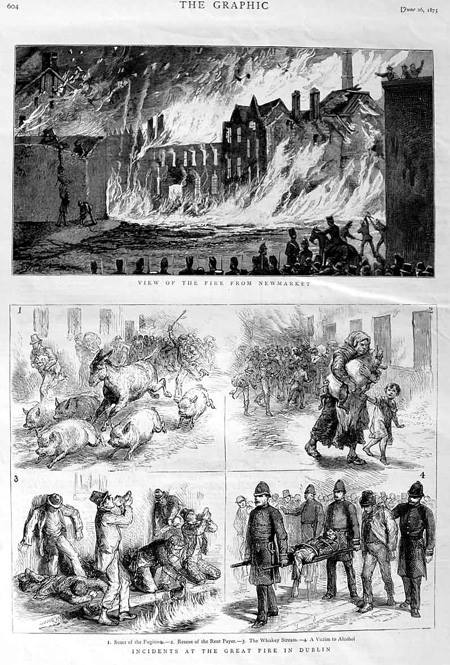
The Great Whiskey Fire of Dublin, 1875. The Great Whiskey Fire of 1875 was when 5000 barrels of whiskey ignited and flowed onto the streets of the Liberties as far as the Coombe killing 13 people. However, not one person died from burns or smoke inhalation but instead the cause of death was alcohol poisoning from drinking contaminated whiskey from the dirty Dublin streets. The whiskey that burned in Dublin City during the blaze would have a value today of over six million euro. The fire began at Malone’s malt house & storehouse on Chamber street, where 5,000 barrels of whiskey and other spirits were being stored. The fire spread rapidly. As flames reached the wooden casks holding the liquor, they burst open, sending a burning river of whiskey flowing through the streets like lava. The blazing booze caught fire to everything it touched, spreading flames so quickly it was impossible to do anything but run, or in some cases, try to capture the precious liquid before it went to waste. In this poor part of nineteenth century Dublin, it wasn’t uncommon to have farm animals living either inside or outside these tenements. As a result, panic ridden animals ran through the streets and only added to the mayhem of lava like whiskey running alongside them. The Dublin Fire Brigade arrived, under the leadership of Captain James Robert Ingram, who had been a fire officer in the New York Fire Department, and was renowned for his “unconventional” strategies to control fires. On one occasion he had ordered his men to resist putting out a fire on a blazing ship in Dublin harbour, and asked the Navy to sink it instead. Ingram knew that to pour water on the fire would be disastrous as the whiskey would float on top of it like petrol and spread the fire throughout the city. Instead, he sent for soldiers and ordered them to pull up paving stones and pour a mixture of sand and gravel on the whiskey. But he soon realized that wouldn’t be enough as the whiskey started to seep through the sand. Horse manure. Heaps of it lay in depots around the city. Ingram ordered that it be brought to the Liberties by the cartload and shoveled back onto the streets, from where it had once come, to form dams. As the burning whiskey met the damp manure it was soaked up and the fire slowly began to subside. Although contained, the flaming deluge seemed certain to hit both the Coombe Maternity Hospital and the Carmelite convent on Ormond Street, until a kindly wind turned the tide away, which the delighted nuns reportedly offered up thanks for a miracle. While considerable structural damage occurred, miraculously not one person died in the flames or from smoke inhalation, however the Whiskey Fire did have victims. As the city burned, crowds gathered around the edges of the flaming booze river and attempted to capture free drinks in pots, pans, hats and boots. The Illustrated London Times noted that:"Crowds of people assembled, and took off their hats and boots to collect the whisky, which ran in streams along the streets. Four persons have died in the hospital from the effects of drinking the whisky, which was burning hot as it flowed. Two corn-porters, named Healy and M’Nulty, were found in a lane off Cork street, lying insensible, with their boots off, which they had evidently used to collect the liquor. There are many other persons in the hospital who are suffering from the same cause. Two boys are reported to be dying, and it is feared that other deaths will follow." The fire proved to be one of the most destructive in the history of Dublin. The mayor set up a fund and several hundred pounds was raised to help those who had lost their homes and furniture. Eight men were carried in a comatose state to Meath Hospital, twelve to Jervis Street Hospital, three to Stevens’ Hospital, and one young man to Mercer’s Hospital. Thirteen people died. None of the deceased perished in the flames, nor did they die of smoke inhalation - each succumbed to alcohol poisoning from drinking “freely of the derelict whiskey”. Tales of the infamous Great Whiskey Fire are still alive today. In 2014, a new blend of craft whiskey was launched called 'Flaming Pig', named after the squeals of fleeing pigs said to have first alerted residents to the fire. Video: Las Fallon tells us the story of the great whiskey fire of 1875 -https://www.youtube.com/watch?v=vw_BjCzW92k Additional info with thanks to Donal Fallon & Dean Ruxton



